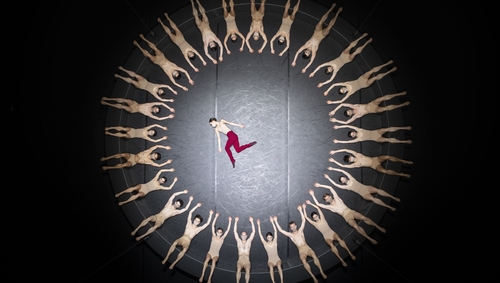Events
|
27.
October 2024.
Sunday at 8:00 p.m.
Main hall
|
CARMINA BURANA by EDWARD CLUG,
|
Sold out
|
Sold out
Edward Clug has undertaken a powerful and poignant reinterpretation of Carl Orff's Carmina Burana, a 20th-century masterpiece that taps into the timeless human themes of hope, love, and destiny. Orff's work, which draws inspiration from medieval verse, speaks to the enduring nature of the human experience, with its opening section, O Fortuna, casting a foreboding shadow over the uncertain fate of humanity.
In revisiting this iconic work, Clug has sought to highlight not only its implicit sense of torment but also its themes of renewal and regeneration, evocative of the springtime season. At the heart of Carmina Burana lies a profound reflection on the human condition, emphasizing our connection to our legacy and our place in the world.
With his fresh interpretation, Clug has breathed new life into this timeless work, tapping into its universal themes and reaffirming its enduring relevance. By emphasizing the central themes of hope, love, and the resilience of the human spirit, Clug has created a production that resonates deeply with audiences, inspiring them to reflect on their place in the world and the legacy they will leave behind.
Choreography Edward Clug
Music Carl Orff
Ballet of Slovene National Theatre Maribor
Set Marko Japelj
Costume Leo Kulaš
Light Tomaž Premzl
Premiered on May 15 2021 in the Slovene National Theatre Maribor
Duration: 1 hour, no intermission
From the choreographer's notebook
The idea to create choreography for the famous stage cantata Carmina Burana by Carl Orff, at the initiative of Ivan Cavallari, artistic director of Les Grands Ballets Canadiens de Montréal, initially seemed absurd to say the least, probably due to prejudices I had about the nature of Orff's music. But upon closer examination of the music, my prejudices proved unfounded, so I am grateful for this experience. The biggest challenge was to find my meaning, my story within Orff's monumental work, and to avoid duplicating what text and music already tell.
The driving force of choreography, following the content of various texts from the medieval manuscript Codex Buranus, is the parallelism between the cycles of nature, especially during the spring awakening of nature, and human life and lust. It is the awakening of lust in the young body, which longs for the forbidden and unattainable (fruit), that represents the movement tension of the journey through twenty-four "songs". The shape that spontaneously emerged was a circle that coincided with the circle of fortune from the first song of O Fortuna and was created by thirty dancers, each of whom aspired to the core of this perfect natural form. The narrower the circle, the more tension and force permeates its core.
Symbolically kneaded, Orff's cantata is undoubtedly still an extremely popular work today, in which I sought mainly spontaneous movement impulses that would address the viewer during the unfolding of the musical flow and unobtrusively include him in this constantly rotating circle of life. Especially in these times of great challenges and personal patience, our world would be revived and reborn through a shared theatrical experience. Orff's own arrangement of a variety of songs offers a myriad of interpretations of the existential question of what happiness, life and love really are, none of which is wrong - but certainly no interpretation is the only correct and universal one.
⸻ Edward Clug








